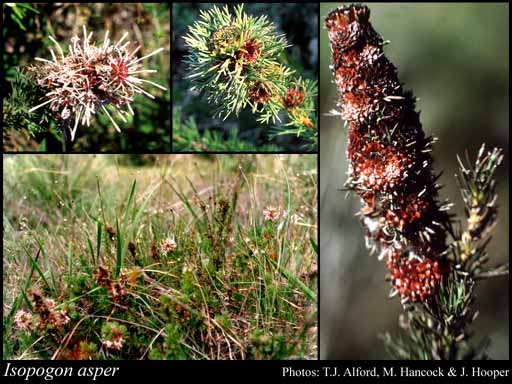- Reference
- Prodr. Suppl. 8 (1830)
- Conservation Code
- Not threatened
- Naturalised Status
- Native to Western Australia
- Name Status
- Current
Generally low spreading, multi-stemmed, lignotuberous shrub, 0.2-0.8(-1.5) m high. Fl. pink/pink-white, Jun to Oct. White, grey, yellow/brown sand, often with gravel, laterite, granite. Hills, granite outcrops.

Scientific Description
Shrubs, 0.5-1 m high, with straight hairs. Leaves alternate, 20-30 mm long, glabrous; lamina terete, twice or more divided, tripartitely divided, divided to the midrib, with 3-5(-8) points or lobes; distance from base of leaf to lowest lobe 6-7 mm. Inflorescences not viscid, pink. Perianth 10-16 mm long, glabrous; pistil 12-16 mm long; pollen presenter not fusiform, hairy, 4-6 mm long, the brush 1.5-2 mm long. Cone with deciduous scales, 18-20 mm long. Flowers in June, July, August, September or October. Occurs in the South-west (SW) Botanical Province(s), in the Geraldton Sandplains (GS), Swan Coastal Plain (SWA) or Jarrah Forest (JF) IBRA subregion(s).
Distribution
- IBRA Regions
- Geraldton Sandplains, Jarrah Forest, Swan Coastal Plain.
- IBRA Subregions
- Dandaragan Plateau, Lesueur Sandplain, Northern Jarrah Forest, Perth.
- Local Government Areas (LGAs)
- Armadale, Canning, Carnamah, Chittering, Coorow, Dandaragan, Gosnells, Kalamunda, Mundaring, Murray, Serpentine-Jarrahdale, Swan, Three Springs, Waroona.